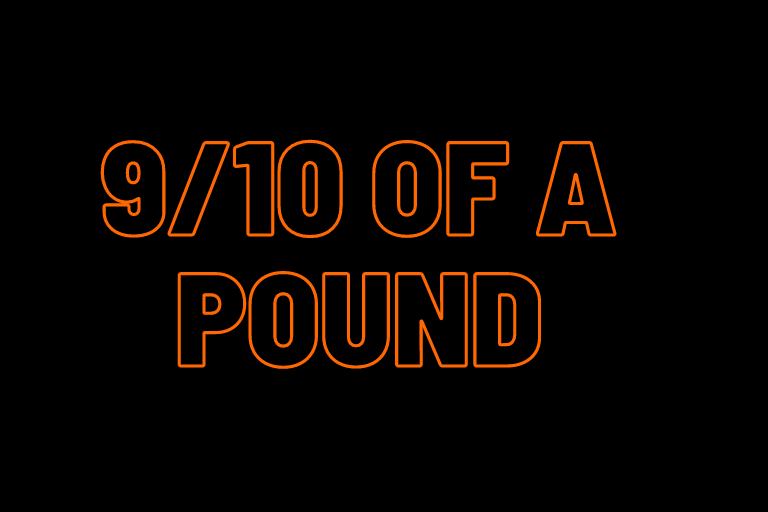9/10 of a Pound
When it comes to weight, we often think about whole numbers. But what if we looked at things a little differently? What if instead of thinking of our weight in terms of pounds, we thought of it in tenths?
One pound equals ten-tenths, so nine-tenths of a pound would be just shy of one whole pound. This may not seem like a big deal, but when the average person gains one to two pounds yearly, nine-tenths of a pound can add up quickly! If you’re carrying around an extra nine-tenths of a pound, it’s time to take action!
Losing even a small amount of weight can significantly benefit your health. So don’t wait – start making changes today and get down to that healthy weight!
MY BIRTH STORY- 10-POUND BABY!
How Many Ounces are in 9/10 of a Pound
There are 16 ounces in a pound, so 9/10 of a pound would be 14.4 ounces.
Oz to Tenths of Pound
When looking at different weight measurements, it must be clear to know what they all mean. Here is a quick guide to understanding the difference between oz and tenths of pounds. Ounces (oz) are a unit of weight in the imperial system, while pounds (lbs) are a unit of mass in the US customary system.
However, both systems use the same pound symbol, “lb.” The main difference between these units is that an ounce is 1/16th of a pound, while a tenth of a pound is 1/10th. So how do you convert from one to the other?
If you have ounces and need pounds, multiply by 16; if you have pounds and need ounces, divide by 16. For example, 10 ounces would be equal to 10 x 16 = 160 or 0.625 lbs, whereas 5 kg would be equal to 5 / 16 = 0.3125 or 3 and 1/8 oz. Generally speaking, people use lbs for things like body weight where more significant amounts are needed, and oz for smaller items like food or drink portions.
1 1/2 Pounds in Half
Like most people, you probably think losing 1 1/2 pounds in half is impossible. Well, I’m here to tell you that it’s not only possible but relatively easy! All you need to do is follow these simple tips, and you’ll be on your way to shedding those unwanted pounds in no time.
First of all, make sure that you’re eating a healthy diet. Cut out all junk food and eat plenty of fruits, vegetables, and lean protein. And make sure to drink plenty of water!
Next, get moving! Exercise is essential for weight loss, so start working out at least 30 minutes daily. If you can’t fit in a full workout, even walking or jogging will help burn calories and tone your body.
Finally, don’t get discouraged if you don’t see results immediately. It takes time and consistency to lose weight, so stick with it, and soon enough, you’ll start seeing the numbers on the scale go down.
8 Cups is How Many Pounds
If you’re wondering how much water you should drink daily, the answer is eight cups. This is equal to two liters or half a gallon of water. While this may seem like a lot, reaching this goal is not difficult.
Here are some tips on ensuring you’re getting your eight cups in. Drink a glass of water first thing in the morning. This will help wake you up and start your day hydrated.
Keep a water bottle with you during the day and take sips whenever possible. If you find yourself getting thirsty, drink more than just a sip! – Drink water with every meal and snack.
Not only will this help you reach your eight-cup goal, but it will also help improve digestion. – Make sure to drink plenty of water before and after exercise. This will help replenish any fluids lost through sweating.
Pounds Decimal
Pounds Decimal is a financial term used to describe the value of a stock or other asset expressed in terms of pounds sterling. The decimal system is used to calculate the value of an asset, and this system uses 100 as its base. In other words, one pound is worth 100 pennies (or pence).
When you hear someone say that a stock is “worth two pounds,” they are referring to the fact that each share of that stock is worth 200 pennies.
Cents Per Pound
Cents per pound is a pricing method companies charge for their goods and services. This system can be helpful for customers when trying to compare prices between different vendors, but it can also lead to confusion and frustration if not used correctly. In this article, we’ll explain how cents per pound works and provide tips on using this pricing method effectively.
When using the cents-per-pound system, companies typically base their prices on the average weight of their products. For example, a company sells tomatoes, and their average tomato weighs one pound. Using the cents-per-pound system, they will charge $0.99 for every pound of tomatoes sold ($0.01 x 100 = $0.99).
The benefit of this system is that customers can easily compare prices between different vendors since the cost is based on weight rather than a specific product or service. However, a few things to remember when using this pricing method: 1) Make sure you know the average weight of the product you’re buying.
Otherwise, you might pay more than you anticipated.
2) Be aware that some products vary in weight from purchase to the next (e.g., produce). This means that your price could fluctuate slightly each time you buy something.
3) Some companies may use different units of measurement (e.g., ounces instead of pounds). Before making your purchase, clarify this with the vendor, so you know what unit of measure they’re using and can accurately compare prices.
Cups to Pounds of Flour
When it comes to measuring flour, there are a few different ways that you can do it. The most common way is by using cups. But what if you don’t have a cup measurer?
Or what if your recipe calls for pounds of flour, and you have a bag of flour sitting in your pantry for a while? Here’s how to convert cups of flour to pounds (and vice versa). One pound of flour is equal to 2 cups.
So, if your recipe calls for 1 pound (2 cups) of flour, and all you have is 1 cup, you’ll need to use half as much flour. To convert from cups to pounds: 1 cup = 0.5 lb
How Many Cups in a Pound
There are 16 cups in a pound.
16 Cups to Lbs
There are many reasons that people might need to know how many cups there are in a pound, from cooking to baking to simple curiosity. Here at 16 Cups, we’ve got you covered! A pound comprises 16 cups, meaning that there are 4 cups in a quarter pound, 2 cups in an eighth pound, and 1 cup in a sixteenth pound.
This can be handy when working with recipes that list ingredients by the pound instead of by the cup. We hope this has been helpful – next time you’re wondering how many cups are in a pound, remember 16 Cups!
Conclusion
This blog post is about a new study that suggests that people who are overweight may be carrying around an extra 9/10 of a pound. The study, which researchers at the University of Texas conducted, looked at data from over 6,000 adults and found that those who were obese had an extra 9/10 of a pound on their bodies compared to those who were not obese. The study also found that this excess weight was associated with an increased risk of developing type 2 diabetes.






